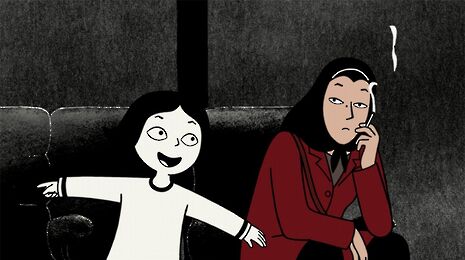VisCourse: Recording Memory
Is film an analogue for our memory or simply a mode with which we can express it? Lydia Sabatini investigates…

Apparently, smell is the sense most closely associated with memory. Nevertheless, much of memory seems an audio-visual experience, like replaying a film inside your mind. But maybe film is more like a dream than an actual memory, being a landscape devoid of a more psychologically visceral sense like smell, leaving something altogether more nebulous and intriguing. Films themselves have always played with time, and used their structure to explore ideas of memory, time and our relationship with the past. Typical cinematic devices include the flashback, or the framing of a prologue and/or epilogue, both of which allow the viewer to return to the present at the end of the film with new insight learned from what we have just seen of the past. On the other hand, some films are more formally daring in presenting ideas about such themes, and consequently ask harder questions about people’s relationship with the past, and explore the sometimes strange and murky boundary between memory, fiction and truth.
“The animated medium is perfect for such a story, because it renders the intense feeling and simplistic lines of a child’s eye-view of the world”
Indeed, ideas about time and the past come into sharper focus when the events and characters dealt with in the film are true. Persepolis (2007), co-directed by Marjane Satrapi and Vincent Paronnaud, is based on Satrapi’s autobiographical graphic novel about growing up in Iran against the backdrop of the Iranian Revolution and its subsequent establishment of the restrictive Islamic Republic. The animated medium is perfect for such a story, because it renders the intense feeling and simplistic lines of a child’s-eye view of the world. Furthermore, free from the visual limitations of live action films, the film can be more expressionistic, using design and colour to show what Marjane was feeling rather than just what happened to her, which captures the way memory and subjective emotion are intrinsically linked.

A more unusual film is Waltz with Bashir (2008). It is not a film that’s easy to classify, a kind of animated docu-memoir. Filmmaker Ari Folman is haunted by his memories, and lack thereof, regarding his time as a soldier during the 1982 Lebanon War. Memory, truth, and art are all mixed together. The first images we see of demonic hounds in harsh dystopian yellow and grey turn out to be Folman’s recurring nightmare which leads him to embark on a journey of remembrance. You are always conscious while watching that his apparently true personal journey has been crafted with hindsight for the audience, emphasising the constructed and artificial nature of all memories. While memories are in a sense creations and will remain coloured by our own narratives, the film reminds us that the horrors of war are inescapably real by shifting, without warning, to non-animated documentary footage of the aftermath of a massacre.
“Oppenheimer engages with the perpetrators, who are living openly, gloatingly, alongside the families of their victims”
The search for the truth of a bloody past through fictionalisation is also explored in The Act of Killing (2012), Joshua Oppenheimer’s remarkable documentary about the Indonesian mass killings of the 1960s. Denied access to the victims of the killings, Oppenheimer engages with the perpetrators, who are living openly, gloatingly, alongside the families of their victims. In a stroke of true innovation, he asks them to act out their crimes, and they are happy to oblige. What follows is utterly surreal, unique and disturbing. The chance to recreate these experiences brings about banally ludicrous scenes of ironic self-glorification, and these men use cinema gangsters as a reference point and a way to glamourise and disassociate from the reality of their murder. Yet what is far more terrible than the boastful performances is what happens when the ‘acting’ quietly ceases, and other memories come to the forefront: memories of blood, nightmares and retching. Fictionalisation is once again used as process to find out the truth about the past, and how people relate to it.
On the other hand, subtle and interesting ideas can occur in a film whose narrative is completely fictional and formally conventional. In fact, the refusal to indulge in any dramatic revelations in Asghar Farhadi’s 2013 film The Past makes it stand out. It is unrelentingly chronological, and follows our characters day by day as they struggle to move forward in their lives, getting tangled in the unclear, conflicting accounts of motivations and events of the recent and distant past. The presence of a woman in a coma, unconscious but alive, is both a plot point and a metaphor for the memories that refuse to die. The film uses a naturalistic tone that precludes the use of any flashbacks, emphasising the necessity of living with an uncertain past. There can be no epiphanies and no definitive answers when your own past and memories are mixed with those of other people, which will remain forever inaccessible. You can never really go back. You can never really know why things happened. Time only goes in one direction, and leaves us only to wonder
 News / Night Climbers call for Cambridge to cut ties with Israel in new stunt15 April 2024
News / Night Climbers call for Cambridge to cut ties with Israel in new stunt15 April 2024 News / Cambridge University cancer hospital opposed by environmental agency12 April 2024
News / Cambridge University cancer hospital opposed by environmental agency12 April 2024 Features / Cambridge’s first Foundation Year students: where are they now?7 April 2024
Features / Cambridge’s first Foundation Year students: where are they now?7 April 2024 Comment / UK universities are sacrificing widening access for foreign fees11 April 2024
Comment / UK universities are sacrificing widening access for foreign fees11 April 2024 Film & TV / Dune: Part Two is a true epic for the ages11 April 2024
Film & TV / Dune: Part Two is a true epic for the ages11 April 2024


